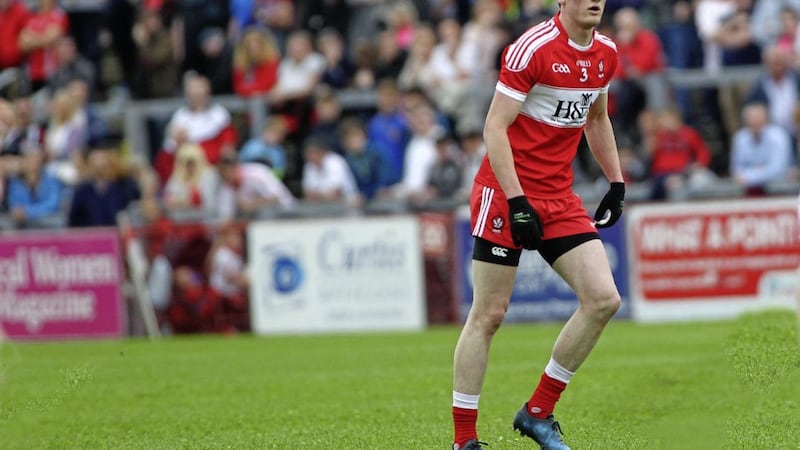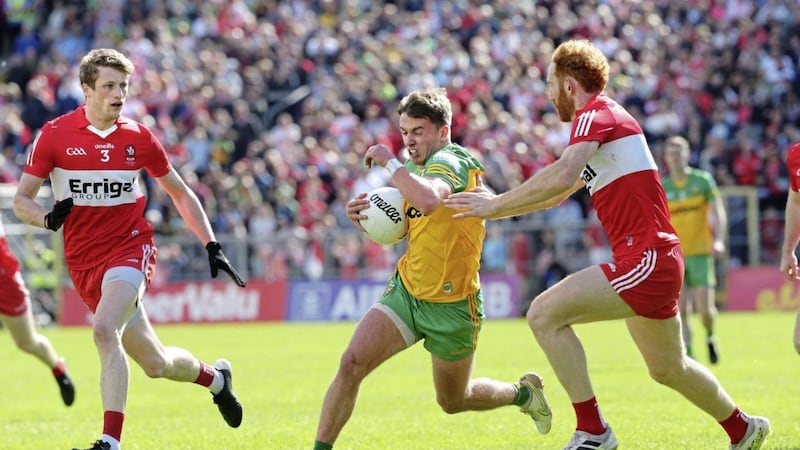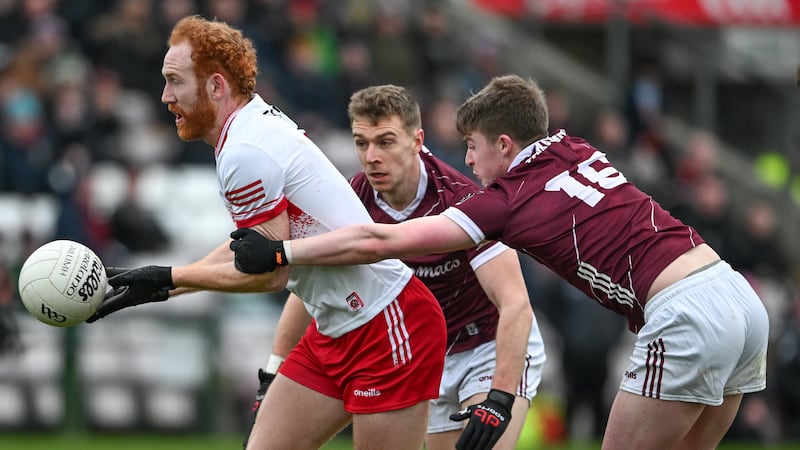IF you’re bored, keep a count this week of how often you see Derry referred to as “a young team, with a raft of players from the good crop of minor teams in recent years.”
The average age of Tyrone’s probable starting team on Sunday will be 25.7.
The average age of Derry’s will be 25.5.
Derry will have three players aged 30 or older, to Tyrone’s one.
In terms of players under 23, it will likely be 4-2 in Derry’s favour, although the idea of Brian Kennedy or Liam Rafferty getting a start for Tyrone is not beyond the realms, which would narrow that gap.
In Niall Keenan and Shane McGuigan, Derry will likely have two Ulster minor medallists from 2015 in their starting team four years on.
Thomas Mallon, Chrissy McKaigue, Ciaran McFaul, Enda Lynn and Emmett Bradley (as well as Benny Heron, who is likely to be used from the bench this weekend) all played in the 2014 National League final defeat by Dublin.
Tyrone will only have five starting men going back to that same summer, although that’s assuming neither Darren McCurry nor Connor McAliskey starts this weekend.
Derry’s youth card doesn’t wash.
There is, however, a huge difference in youth and inexperience. That is where the gap between the two teams exists.
Tyrone are likely to go with at least 12 of last year’s All-Ireland final team.
Colm Cavanagh will make his 64th championship appearance in the white and red on Sunday. It will be Mattie Donnelly’s 43rd.
If you remove Chrissy McKaigue’s 21 appearances from the Oak Leaf numbers, then Cavanagh and Donnelly (105) have played almost as many championship games as the rest of the Derry team combined (111).
Therein lies not only what will prove to be the difference this weekend, but the challenge for the Oak Leafers as they look over the next few years to discover the level on which Mickey Harte’s men operate.
There are a few serious players on their way through in Derry, thanks largely to huge work being done by the clubs, as well as the bits being added on at the end in Owenbeg.
The under-20s will be at the forefront in Ulster over the next few seasons, with the expectation that by 2022, the county may finally be primed for an assault on senior titles.
That’s where the current age profile becomes critical. In 2022, Karl McKaigue and Emmett Bradley will be 29. Brendan Rogers, Ciaran McFaul and Ryan Bell will be 28, Padraig Cassidy 27. Niall Keenan and Shane McGuigan will have turned 25.
There’s your nucleus. Throw in a bundle of 21, 22, 23-year-olds with a winning mentality and you have the age profile and quality of a team that could properly compete.
When you lay it out in its bare skin like that, and you juxtapose it with where Tyrone will be in three or four years’ time, then there really ought to be a significant narrowing of the gap.
Is there enough coming behind them to solidify Tyrone’s current position? Take that this revival of the last few years has been built largely around those seven men, with the fringes around them evolving to the point where they are serious All-Ireland contenders once more.
But it’s looking increasingly like a short window for them. They haven’t won an Ulster minor title since 2012, haven’t been in a final since 2013.
By 2022, Niall Morgan, Ronan McNamee, Tiernan McCann, Peter Harte, and Mattie Donnelly will all be 30-plusses, Niall Sludden will be 29 and Colm Cavanagh will be retired. You can win with a few elder statesmen, but not that many. This team will either have begun to break up, or they’ll no longer be winning.
Recent months have seen an overhaul of their coaching structures, with Gavin Devlin taking over at the head of their development squads.
And ultimately, as the sands of time pass quicker and the drift between top and bottom in the GAA becomes more pronounced, where Tyrone will retain an edge on Derry is in the county’s subconsciousness.
Every young footballer in the O’Neill county grows up desperate to pull on that jersey. Absolutely desperate.
That mindset, almost above anything else, is what drives the constant success they’ve had for the last 20 years.
It propels the depth in standard of their club football to greater and greater heights, which keeps the belt rolling for operations at the top end.
Those that get the chance to play for Tyrone rarely pass it up. None of the 15 that will start in Healy Park this weekend have taken a year out of inter-county football or gone for a summer in America or defied Mickey Harte over playing club games.
That means the same men are out in Garvaghey training night after night, week after week, year after year. They’re able to develop both as footballers and as the athletes that they’ve become, and have needed to be.
Derry, meanwhile, have been chopping and changing squads for a decade. Every summer, two or three men out of their 26 are heading for America. The winter inevitably sees half-a-dozen tail off.
The few regulars that have been there for the last five years spend each pre-season having to get to know the man sitting beside them all over again.
The biggest impact is physically. The time and effort and money invested in conditioning a player for ten months and then they go out the revolving door, replaced by someone else. A year later, they’re gone. It’s a cycle that keeps repeating itself and one that Derry are struggling to break.
That’s not saying that footballers in the Oak Leaf county are wrong to prioritise their lives outside football, that they’re wrong to go to America or wrong to weigh the plusses and the minuses and decide inter-county football isn’t worth it.
But if Derry football ever wants to get to the level that, with the recent run of quality minor teams coming in, it has the potential to get to, then they have to take a core of 7 or 8 current senior players, move heaven and earth to keep them at Owenbeg together and build a team around them.
And when they settle on the 7 or 8 most talented under-20s that will make the breakthrough in the next few years, then they must integrate them and do the same.
The 2002 and 2007 minor teams were viewed as great opportunities for Derry football, but they were each in isolation. You’ll only ever get two or three off any team in any county.
These minor teams from 2015 to now have come one after the other for what is now five years running, and that represents a strength in terms of underage that the county hasn’t had since St Pat’s Maghera were at their peak in the 1980s.
If Derry can find a way to build a tight, core unit of 20 men, then they’ll be going to Healy Park in five years’ time and winning.
That’s a huge ‘if’, but it’s what will determine whether this will be a golden generation for Derry, or another wasted one.








